Inventions
Wasabi Smoke Alarm
Posted By: Paul - Tue Oct 04, 2011 -
Comments (4)
Category: Food, Inventions, Asia
Canine Elevator
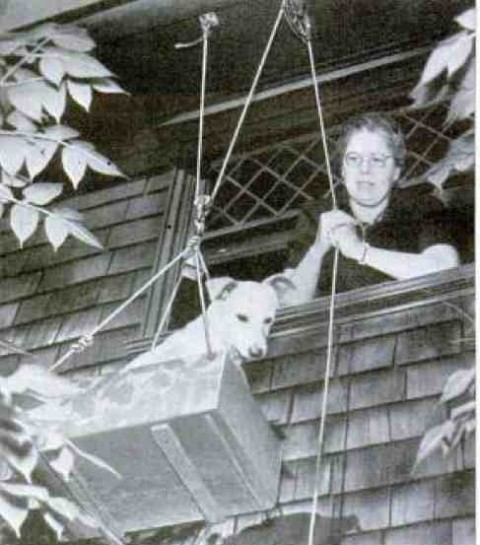
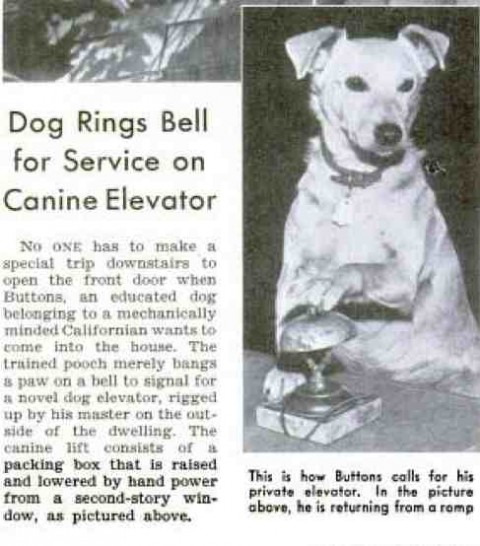
Didn't people have anything important to occupy their labors in olden days?
Posted By: Paul - Wed Sep 28, 2011 -
Comments (4)
Category: Inventions, Chindogu, Dogs, 1930s
Crazy Machine
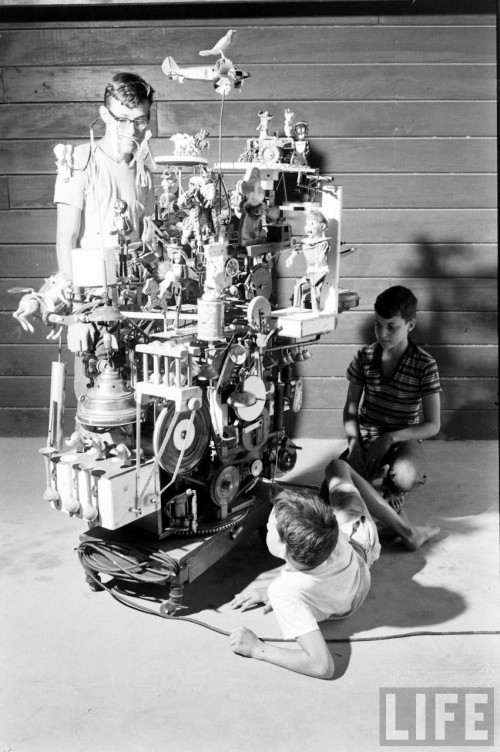
This image is found on the photo archives of Life magazine under the title above. I cannot discover any accompanying article to explain what this device is. Your best guess?
Posted By: Paul - Sun Sep 18, 2011 -
Comments (7)
Category: Inventions, Mad Scientists, Evil Geniuses, Insane Villains
Mystery Gadget 2
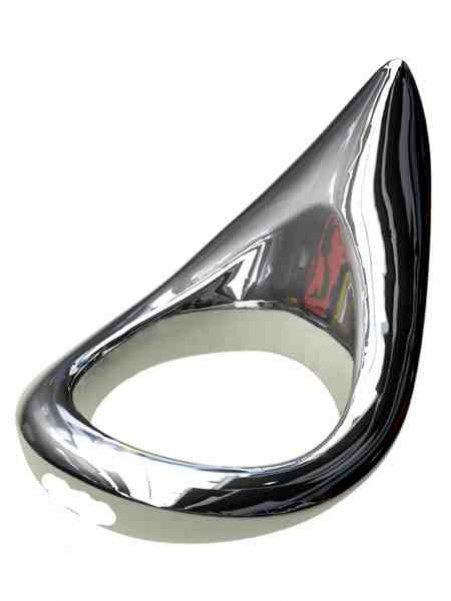
Answer at this link.
The smudge on the lower portion is where I erased the brand name.
Please note the price, when you go to look.
Posted By: Paul - Mon Aug 22, 2011 -
Comments (12)
Category: Ambiguity, Uncertainty and Deliberate Obscurity, Inventions
Johnson Smith Catalog Item #4
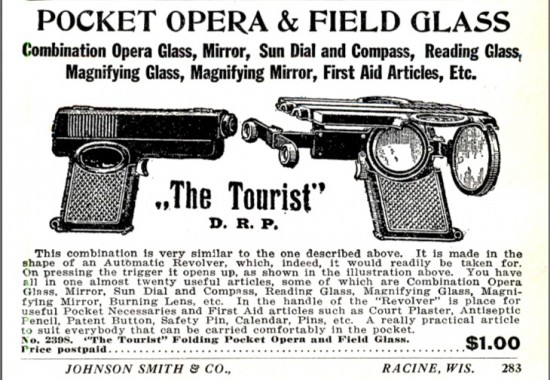
Imagine walking into the opera house today with this in hand.
From the 1930s catalog.
Posted By: Paul - Sat Aug 06, 2011 -
Comments (2)
Category: Inventions, Johnson Smith Catalog, 1930s
Raymond Scott
You heard Raymond Scott backing Jim Henson yesterday. And cartoon and music fans are well aware of composer Scott for his famous tune POWERHOUSE.
But did you also know he was an early pioneer in weird electronic music?
Posted By: Paul - Thu Aug 04, 2011 -
Comments (1)
Category: Inventions, Music, 1940s, 1950s
Carstache!
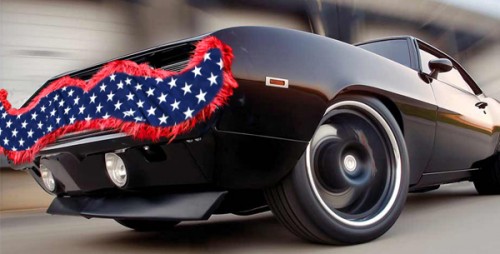
Car bras? That's old school uncool! Your vehicle needs a 'stache. Visit Carstache to learn more, especially about their newest, pictured here and available just in time for July 4th!
All thanks to WU-vie Ethan Eyler.
Posted By: Paul - Thu Jun 09, 2011 -
Comments (1)
Category: Inventions, Reader Recommendation, Bohemians, Beatniks, Hippies and Slackers, Cars
Jetpack Flies One Mile High
Full video here.
Posted By: Paul - Mon May 30, 2011 -
Comments (5)
Category: Eccentrics, Inventions, South Pacific
Weird Science – Yet More Robots
In a strange case of the left manipulator not knowing what the right manipulator is doing, here are two more robots that I somehow managed to miss off yesterday’s post.First up is the obvious and long overdue companion to yesterday’s beer fetching robots; a robot that can flip pancakes. Obviously there have been automated pancake makers around for a while now, but this robot from the Italian Institute of technology has learnt how to flip a good pancake by seeing how humans do it. Please, Dr. Kormushev, teach it to fry bacon next (Vimeo).
But if some groups are concentrating on robots that ply you with beer and pancakes, Autom’s mission in life is to help you lose weight and live healthily. The brainchild of Cory Kidd, who had the idea while at MIT, Autom first asks you for details of your diet, fitness and exercise regime, then it has daily 'conversations' with you during which it will dispense diet and exercise advice. Apparently a major insurance company intends to trial Autom in the US sometime next year, so we can all look forward to having one of these nag us each morning as a mandatory requirement of our health plan (Engadget).
Hmm, perhaps I could teach the pancake robot to flatten the annoying little thingamajig with its frying pan before making my breakfast stack?
Posted By: Dumbfounded - Fri Jul 23, 2010 -
Comments (5)
Category: Exercise and Fitness, Futurism, Health, Inventions, Robots, Technology
Weird Science – Invention Is The Mother Of Necessity
Build a better mousetrap, it is said, and the world will beat a path to your door. The implication being that there are some problems which are just crying out for a solution. And then there are the solutions crying out for a problem - those inventions that, while inspired, are just a tad “out there”. It is this later category I shall be celebrating today.First up, how clean is your cow? This age old problem has nagged at the minds of farmers down the ages, are their cows clean enough? And why isn’t there an easier way to clean cows? Well these merchants of the soil need worry no more thanks to a Swedish company that has developed the fully automated “cow wash”. Supposedly improving the health and yield of cows that use it, the cow wash uses a free swinging revolving brush to groom the cows while simultaneously stimulating their circulation. Apparently the cows enjoy using it and the makers DeLaval have sold over 30,000 in Sweden alone (Daily Mail).
Bigwigs in the US military will also soon be able to sleep sounder in the knowledge that the men under their command are safely in their underpants. We’re not just talking about any undies though, these have been specially designed by University of California professor Joseph Wang. Not only will his techno-trunks monitor the vitals of the personnel wearing them, they can even administer painkillers or antibiotics as the situation demands (Post Chronicle).
And if your pants don’t save you, at least your modesty will be preserved when you are taken to hospital, all thanks to the University of Montreal. For it is from that fine establishment’s School of Industrial Design that our next invention hails, a hospital gown that isn’t quite so revealing. The DUO gown is the brainchild of Noemie Marquis and Denyse Roy and consists of two overlapping panels, front and back, that is easy to put on and requires no fasteners making life simpler for both patients and staff (Medical News Today).
Meanwhile British scientists have been working on an altogether sterner cover. Nicknamed “bullet-proof custard” by its inventors, Bristol based BAE systems have developed a liquid armour consisting of layers of Kevlar combined with a secret “shear-thickening” liquid that hardens as force is applied. The company’s eventual aim is to produce lighter, more-flexible body armour for the military (BBC News).
More in extended >>
Posted By: Dumbfounded - Thu Jul 22, 2010 -
Comments (9)
Category: Animals, Farming, Bicycles and Other Human-powered Vehicles, Futurism, Hospitals, Inventions, Robots, Science, Technology, Underwear

| Who We Are |
|---|
| Alex Boese Alex is the creator and curator of the Museum of Hoaxes. He's also the author of various weird, non-fiction, science-themed books such as Elephants on Acid and Psychedelic Apes. Paul Di Filippo Paul has been paid to put weird ideas into fictional form for over thirty years, in his career as a noted science fiction writer. He has recently begun blogging on many curious topics with three fellow writers at The Inferior 4+1. Contact Us |




